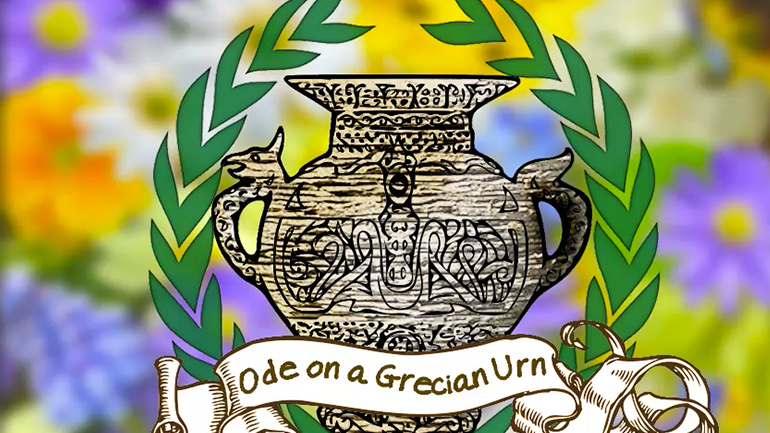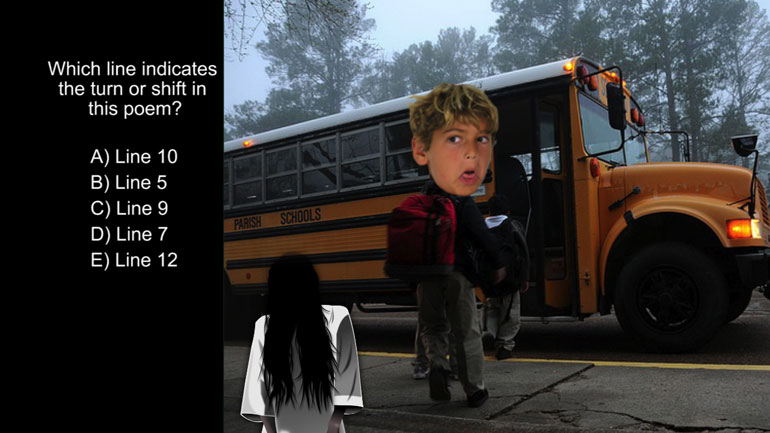ShmoopTube
Where Monty Python meets your 10th grade teacher.
Search Thousands of Shmoop Videos
AP English Literature and Composition DBQ/Free Response 361 Views
Share It!
Description:
AP® English Literature and Composition: DBQ/Free Response. Compare and contrast the perspectives on the subject at hand, as well as the different ways each poet gets their message out there.
Transcript
- 00:04
Here's your shmoop du jour, brought to you by Autumn.
- 00:07
So many bare trees, and not one of them feels an ounce of shame.
- 00:11
Okay, so we have a "dueling Emilys" situation on our hands here...
- 00:14
...one poem by Emily Bronte and one by Emily Dickinson.
- 00:18
They're both about the fall, they're both eight lines long, and neither one especially
Full Transcript
- 00:22
makes you want to throw on a pair of swim trunks and head to the beach.
- 00:25
So... what are we supposed to do?
- 00:27
Well, our instructions are to compare and contrast the perspectives on the subject at
- 00:31
hand -- namely, autumn -- as well as the different ways each poet gets their message out there.
- 00:36
Okay, a starting point would be good...
- 00:38
Before we begin, we really need to delve into each poem and figure out what is significantly
- 00:43
different about the two.
- 00:44
Is one upbeat and the other pessimistic?
- 00:47
Does one approach the subject vaguely and the other paint a clear picture?
- 00:50
Is one pro-September and the other fiercely pro-October?
- 00:54
Okay, so now that we know what the prompt is...
- 00:56
prompting us for...
- 00:57
...it's time for some good old-fashioned analysis.
- 01:00
One of the main things we're looking for here are the literary devices at play.
- 01:04
Both authors have chosen the same topic, but they employ different techniques to portray
- 01:08
unique viewpoints of it.
- 01:10
So... what are those techniques?
- 01:12
No better place to start than with the title.
- 01:15
"Fall, Leaves, Fall" has a trochaic rhythm of stressed and unstressed syllables.
- 01:23
Basically... it slows down the reading of the poem.
- 01:25
For example, you could probably zip your way through a random shopping list pretty quickly.
- 01:28
But if you have to read the lyrics to a song as quickly as possible...
- 01:32
you might have a tougher time.
- 01:34
It's because there's a natural melody, a rhythm, a beat to the language.
- 01:38
WHY would Bronte want to slow down the poem?
- 01:41
Well, probably because she wants the experience to feel something like her depiction of fall.
- 01:46
Slow, sad... and a bit painful.
- 01:49
Not surprising.
- 01:50
The Brontes were never really known for being "uppers."
- 01:53
See: Wuthering Heights.
- 01:55
Autumn has a rhythm as well... as does just about all poetry... but it's a much more familiar,
- 02:01
iambic rhythm, with a typical A-B-A-B rhyme scheme.
- 02:06
It flows from the lips -- or the brain -- with greater ease...
- 02:09
painting an entirely different picture of the season as
- 02:12
one that is soothing... calming... and painless.
- 02:16
Now... what about diction, or word use?
- 02:18
Look at the words Bronte uses: die, decay, drearier...
- 02:23
Aside from them all being "d" words, they're all...
- 02:26
depressing. Oh, look -- another "d" word.
- 02:29
In Autumn, Dickinson instead relies on word choices like "plumper" and "gayer."
- 02:34
No, she's not writing an ode to Bruce Vilanch.
- 02:37
In this instance, she means "gayer" as "happier."
- 02:40
Her word choices make us long for it to be autumn...
- 02:43
because we could use a little gaiety in our lives.
- 02:46
Dickinson also uses personification, which makes the season feel alive...
- 02:50
...while Bronte doesn't. So her depiction of fall is...
- 02:53
lifeless. Just the way she lives it.
- 02:56
Okay, now that we've determined the major differences between viewpoints and technique,
- 02:59
we can form a thesis and get this show on the road.
- 03:02
You could go a couple ways with this... either by focusing on the tone of each poem...
- 03:07
"While the speaker of Dickinson's poem rejoices in the evidence of life in autumn, the speaker
- 03:11
of Bronte's rejoices in the evidence of death"...
- 03:15
...or you could zero in more on the literary device angle...
- 03:18
"The speaker of each poem celebrates autumn, and the authors reveal the speaker's perspectives
- 03:23
through rhythm, diction, and figurative language."
- 03:26
Then, when writing the essay itself, be sure to both compare AND contrast...
- 03:30
...in other words, don't just talk about how the two poems are different and forget to
- 03:34
show how they're also SIMILAR.
- 03:36
Like... they both use the word "rose."
- 03:39
But... probably a little more in-depth than that.
- 03:41
Before you start a-writin'... or maybe after you're done...
- 03:44
check out this sample essay to get an idea of what those AP gurus are looking for...
Up Next
AP English Literature and Composition 1.2 Passage Drill 4. As which of the following is the object being personified?
Related Videos
AP English Literature and Composition 1.4 Passage Drill 3. How is Burne's view of pacifism best characterized in lines 57 through 67?
AP English Literature and Composition 1.6 Passage Drill 5. Death is primarily characterized as what?
AP English Literature and Composition 1.7 Passage Drill 5. Which line indicates the turn or shift in this poem?
AP English Literature and Composition 1.9 Passage Drill 4. Lines 32-34 are best understood to mean what?




